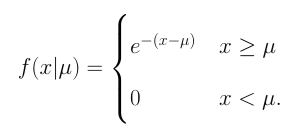< Probability and statistics definitions < Threshold parameter
The threshold parameter defines defines the minimum value that is theoretically possible for data from a probability distribution. We can either discard all information below the threshold – -which would eliminate outliers — or choose to keep the information if outliers are of interest.
The threshold parameter is sometimes called the location parameter, but it is not the same location parameter used in probability distributions to denote the mean.
Threshold parameter examples
The threshold sometimes appears in common probability distributions, including:
- Beta distribution
- Exponential distribution
- Gamma distribution
- Lognormal distribution
- Weibull distribution.
Depending on which distribution you’re working with, you might see the threshold denoted as µ, θ, or γ.
Suppose we have an exponential distribution — f(x) = e−x, x ≥ 0, and f(x) = 0, x < 0 — and we want to convert it to an exponential location family. To do this, we replace x with x – µ:

The threshold here, denoted µ, denotes a bound on the range of x [1].
Drawbacks with using a threshold parameter
It can be challenging to choose an appropriate threshold parameter because traditional methods, such as referring to a mean excess plot or choosing a certain percentile does not guarantee an appropriate threshold selection was made. This can lead to model bias or violation of the independence condition of excess.
In some cases, setting a threshold parameter is never a good choice. For example, if we are interested in the distribution of very rare events, then we wouldn’t want to discard all data points below a certain threshold [2].
The inclusion of a threshold parameter can also create problems with analysis. For example, the maximum likelihood estimator of the threshold parameter γ for the three-parameter lognormal distribution is the smallest order statistic greater than γ, but inclusion of this third parameter may create trouble in estimating scale parameters for the three-parameter lognormal distribution [3]. The threshold parameter can artificially inflate the scale parameter — the standard deviation of the distribution on the logarithmic scale — because γ removes the smallest data points from the distribution, which are often the most variable.
References
[1] Common Families of Distributions
[2] Behrens, C. et al. (2003). Bayesian Analysis of Extreme Events with Threshold Estimation. Retrieved August 18, 2023 from: https://citeseerx.ist.psu.edu/viewdoc/download;jsessionid=19B83FFAE1F4841926EBC771FB0C8C39?doi=10.1.1.71.3689&rep=rep1&type=pdf
[3] Aristizabal, Rodrigo J., “Estimating the Parameters of the Three-Parameter Lognormal Distribution” (2012). FIU Electronic Theses and Dissertations. 575.
https://digitalcommons.fiu.edu/etd/575